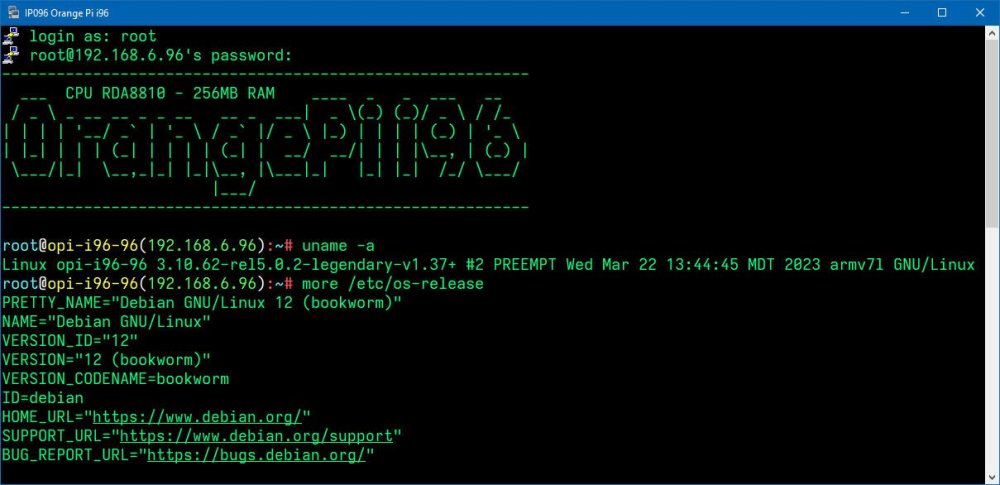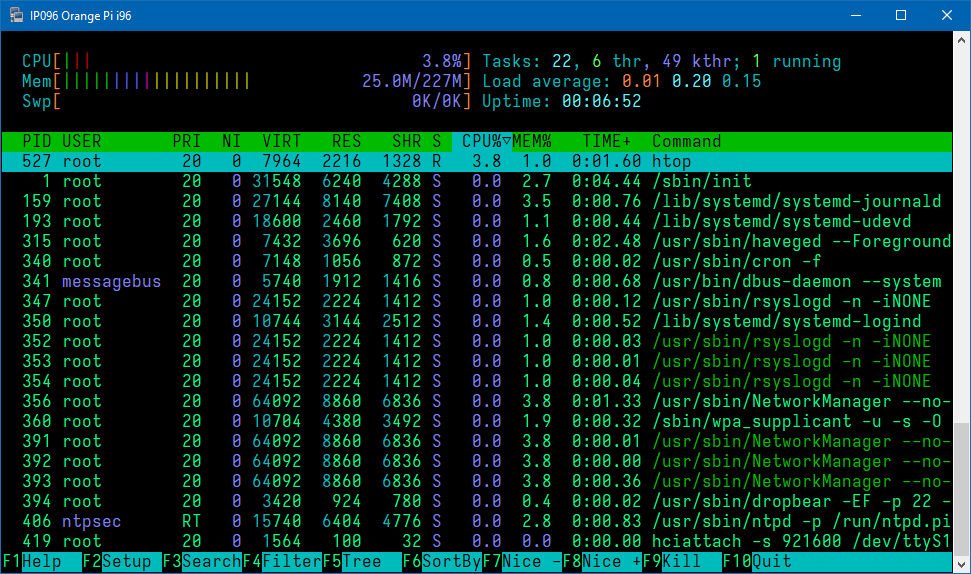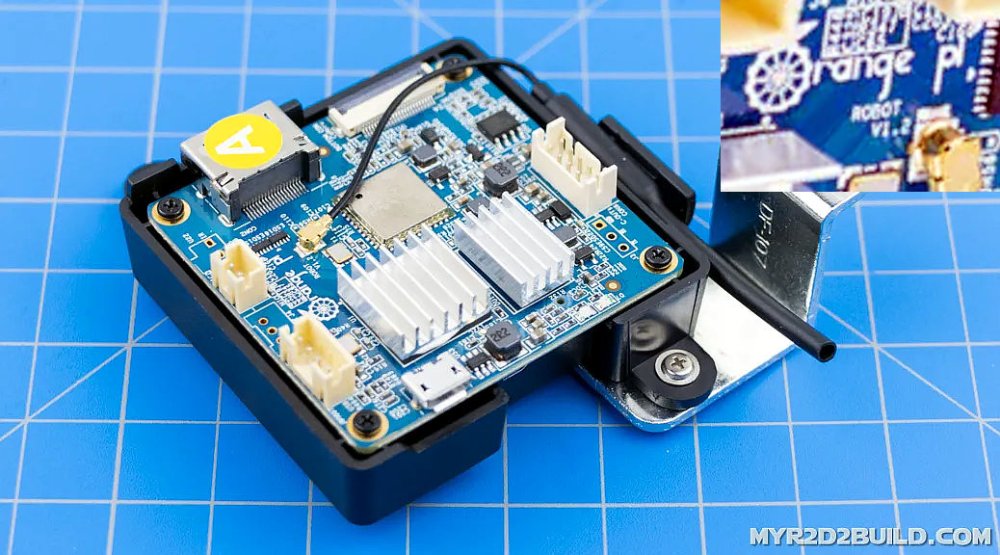-
Posts
1797 -
Joined
-
Last visited
Profile Information
-
Gender
Male
-
Location
Mudanya
Recent Profile Visitors
11927 profile views
-

[Info] Pinebook A64 Display Brightness at bootup with CLI-only-image
guidol replied to guidol's topic in Allwinner sunxi
Like on the OrangePi's which have problems with the latest Community Edition (kernel 6.6.x and their armbian-firmware) I went back to the most actual stable image before kernel 6.6.x (non-Community Edition?) for the Pinebook A64 which can be found at https://armbian.hosthatch.com/archive/pinebook-a64/archive/Armbian_23.11.1_Pinebook-a64_bookworm_current_6.1.63.img.xz You do get a non-Desktop system with Armbian 23.11.1 Pinebook-a64 bookworm current kernel 6.1.63 then do a Kernel-Freeze in armbian-config -> system apt update/upgrade and you will end with a stable Armbian 24.5.1 Bookworm with Linux 6.1.63-current-sunxi64 This will recognize my 14" Screen, WiFi and Ethernet (USB) -

[Info] Pinebook A64 Display Brightness at bootup with CLI-only-image
guidol replied to guidol's topic in Allwinner sunxi
@Gunjan Gupta Today I did try the following images Armbian_community_24.8.0-trunk.205_Pinebook-a64_noble_current_6.6.31_gnome_desktop.img and Armbian_community_24.8.0-trunk.205_Pinebook-a64_bookworm_current_6.6.31_minimal.img on my 14" (1080p?) Pinebook non-Pro A64, but I do get only a black screen It didnt help to use echo 8 > /sys/devices/platform/backlight/backlight/backlight/actual_brightness or the pkexec-command The screen lights up, but to information on the screen. I had only (sometimes) access via a USB-Ethernet-Adapter. But at some boots the ethernet wasnt recognized and the onboard-Wifi doesnt sho up The last version I could get my screen to work - with a CLI-version of bookworm - is 24.2.0 of armbian (after update?) I dont know how to switch via 720p/1080p for the different screensizes of the Pinebook A64 non-Pro (I have 14" and not 11.6") BTW: after updateing the 24.2.0 of armbian via apt update/upgrade the system is also non-working (Black screen and no ethernet and no Wifi) Its has updated to kernel 6.6.31 and this was also the "death" to some of my OrangePi installations The "Community Editions" are at this time unuseable (because non-tested) - this could end in a bad reputation also for the supported devices - as I think. For me its software-obsoleszenz - rendering working hardware into a paperweight -

Looking for a previous CLI release of Jammy for Orange Pi Zero
guidol replied to av4625's topic in Allwinner sunxi
why not taking the minimal and install the packages that you need? I only also did find another url, but here isnt a different content: https://mirror.yandex.ru/mirrors/armbian/archive/orangepizero/archive/ I had problems with the new kernel 6.6.31, so I used a older one like you and freezed the kernel before updating in armbian-config -
> Back in March I ran into problems with the community builds for the NanoPi Neo, for Debian Bookworm. It would boot up initially, > but within 30 minutes or so, it would crash. So I did a fresh install from the last official build I had saved from June 2023: > Armbian_23.5.2_Nanopineo_bookworm_current_6.1.30 Dear @dave3 I had the same problem with my three NanoPi Neo2 (the H5 version of the Neo) I went for the (latest) 6.1.36 image and did also the freeze kernel/firmware (now they are running cool/stabe:
-

NanoPi Neo2 login stuck past entering user/password after Update
guidol replied to guidol's topic in Allwinner sunxi
I dont know was it was - with updated armbian (with Kernel 6.7.12-edge-sunxi64 or 6.6.31-current-sunci64) I do get a high cpu load and couldnt login anymore. Because of the CPU load the temperature gets high as 73-89 degree celsius Because I could login or find a error (maybe the installation is too old or too mich times updated) I didi go the way of fresh install, but had to avoid to much kernel/firmware to kernel 6.6.31-current-sunxi64.... So I ended in reinstalling all my 3 Neo2 as base-system with Armbian_23.11.1_Nanopineo2_bookworm_current_6.1.63 (latest full cli-image for bookworm for download) After initial setup (user/passwd/timezone) I did freeze kernel/firmware in armbian-config. Then updated via apt update/upgrade to Welcome to Armbian 24.5.1 Bookworm with Linux 6.1.63-current-sunxi64 With that my 3 Neo2 do work stable at 43 degree Celsius (when my room is at around 29 degree celsius) - like it was before the critical update. because they are mostly samba-servers (in theit siler aluminum-case) it should'nt be a problem to use only this kernel. When it works - it works - never change a running system login as: root root@192.168.6.22's password: _ _ ____ _ _ _ ____ | \ | | _ \(_) | \ | | ___ ___ |___ \ | \| | |_) | | | \| |/ _ \/ _ \ __) | | |\ | __/| | | |\ | __/ (_) | / __/ |_| \_|_| |_| |_| \_|\___|\___/ |_____| Welcome to Armbian 24.5.1 Bookworm with Linux 6.1.63-current-sunxi64 No end-user support: community creations System load: 6% Up time: 1 min Memory usage: 22% of 482M IP: 192.168.6.22 CPU temp: 43°C Usage of /: 14% of 15G storage/: 2% of 229G storage temp: 40°C RX today: 158.1 MiB [ Kernel and firmware upgrades disabled: armbian-config ] Last check: 2024-06-05 22:23 [ General system configuration (beta): armbian-config ] Last login: Wed Jun 5 22:06:23 2024 from 192.168.6.17 root@npineo2-22:~# -
Today I did update my 3 NanoPi Neo2 via apt update/upgrade, but only one is accessable via ssh after the update. (without SSH/SSL-conect also no conection via SFTP/WinSCP because if the timeout) The one which is accessable has after the update Welcome to Armbian 23.02.2 Bullseye with bleeding edge Linux 6.7.12-edge-sunxi64 ( Machine model: FriendlyARM NanoPi NEO 2) The two other do show prompts for user/password but doesnt login via ssh - and after some time they time out and I can reenter user/password After connecting via TTL-serial I can also enter user/password and then the Neo2 shows me: _ _ ____ _ _ _ ____ | \ | | _ \(_) | \ | | ___ ___ |___ \ | \| | |_) | | | \| |/ _ \/ _ \ __) | | |\ | __/| | | |\ | __/ (_) | / __/ |_| \_|_| |_| |_| \_|\___|\___/ |_____| Welcome to Armbian 23.8.1 Bullseye with bleeding edge Linux 6.7.12-edge-sunxi64 No end-user support: community creations System load: 266% Up time: 2 min Memory usage: 22% of 982M IP: 192.168.6.24 CPU temp: 73°C Usage of /: 54% of 15G storage/: 56% of 458G storage temp: 41°C RX today: 4.2 GiB [ General system configuration (beta): armbian-config ] Last login: Tue Dec 27 14:13:30 +03 2022 from 192.168.6.17 on pts/0 After prssing Ctrl-C: ^C Armbian 23.8.1 bullseye ttyS0 npi-neo2-24 login: For non-existing users I do get a timeout at the serial-TTL-Port: npi-neo2-24 login: maxandmoritz Password: Login timed out after Armbian 23.8.1 bullseye ttyS0 npi-neo2-24 login: but nothing more - and this time the login doenst time out. But the armbian seems to boot up correctly, because the SAMBA-server on the Neo2 is available/useable. So the only way to change something in the system will be to make modifikations to the SDCard - but which change have I to do? Maybe its something between the Neo2 Revisions 1&2 (not/no Black Revision). Does anyone got a glue/idea for me? Thanks in advance Guido
-
Normally when you have installed a XFCE-Desktop image for the Pinebook A64 you could set the display brigthness with the following pkexec command to a readable higher level - like I did in the past (possible brightness values are 1-10 - on startup this is only set to 2): pkexec /usr/sbin/xfpm-power-backlight-helper --set-brightness 8 read-out command for the current value: pkexec /usr/sbin/xfpm-power-backlight-helper --get-brightness but on standard CLI-install pkexec and xfpm-power-backlight-helper are missing, so to use this command-line (in /etc/rc.local) you have to install these 2 packages: sudo apt install xfce4-power-manager pkexec
-
Couldnt get the USB-Gigabit-Ethernet to work after/in a passive USB-Hub The Kernel (3.1.x) seem to have no support for a CIFS/Samba-Mount I had problem after update to bookworm with the openssh-server (only connection reset) and so I installed dropbear and vsftpd (because openssh-sftp was also deinstalled with openssh-server) lsusb Bus 001 Device 003: ID 2001:f103 D-Link Corp. DUB-H7 7-port USB 2.0 hub Bus 001 Device 001: ID 1d6b:0002 Linux Foundation 2.0 root hub [ 302.008300] usb 1-1: new high-speed USB device number 4 using musb-hdrc [ 302.152099] hub 1-1:1.0: ignoring external hub [ 388.976745] usb 1-1: new high-speed USB device number 18 using musb-hdrc [ 389.124877] hub 1-1:1.0: ignoring external hub
-
@whitefeather Its a long time ago - but did read this read today again and found a debian bulleye image (v1.37) on his page from March 2023 ; Debian Bullseye Image v1.37 So maybe that will give a "new life" for my i96 more /proc/cpuinfo Processor : ARMv7 Processor rev 1 (v7l) processor : 0 model name : ARMv7 Processor rev 1 (v7l) BogoMIPS : 370.93 Features : swp half thumb fastmult vfp edsp thumbee neon vfpv3 tls vfpv4 CPU implementer : 0x41 CPU architecture: 7 CPU variant : 0x0 CPU part : 0xc05 CPU revision : 1 Hardware : rda8810 Revision : 0000 Serial : 0000000000000000
-
@Vidor armbian may see/use the RTL8188CUS as RTL8192CUS like on my Logilink WL0084A (which should have a RTL8188CUS): TP-LINK TL-WN725N Rev V1 - RTL8188EU [247548.026879] usb 1-1: new high-speed USB device number 3 using ehci-platform [247548.186436] usb 1-1: New USB device found, idVendor=0bda, idProduct=8179, bcdDevice= 0.00 [247548.187113] usb 1-1: New USB device strings: Mfr=1, Product=2, SerialNumber=3 [247548.187144] usb 1-1: Product: 802.11n NIC [247548.187170] usb 1-1: Manufacturer: Realtek [247548.388942] r8188eu: module is from the staging directory, the quality is unknown, you have been warned. [247548.498252] usbcore: registered new interface driver r8188eu [247549.167691] r8188eu 1-1:1.0: Firmware Version 11, SubVersion 1, Signature 0x88e1 Logilink WL0084A - RTL8188CUS - like TP-LINK TL-WN725N Rev V2/V3 [247297.741636] usb 1-1: Product: 802.11n WLAN Adapter [247297.741675] usb 1-1: Manufacturer: 802.11n WLAN Adapter [247298.168480] rtl8192cu: Chip version 0x10 [247298.465056] rtl8192cu: Board Type 0 [247298.466340] rtl_usb: rx_max_size 15360, rx_urb_num 8, in_ep 1 [247298.467873] rtl8192cu: Loading firmware rtlwifi/rtl8192cufw_TMSC.bin [247298.470442] ieee80211 phy1: Selected rate control algorithm 'rtl_rc' [247298.479578] usbcore: registered new interface driver rtl8192cu So there are good chances that you adapter will work
-
@Vidor this may depend on the hardware-revision do you get at this time the are 3 versions V1 has the Realtek RTL8188CUS as chipset http://en.techinfodepot.shoutwiki.com/wiki/TP-LINK_TL-WN725N_v1 and the V2 and V3 seems to have the Realtek RTL8188EUS as chipset http://en.techinfodepot.shoutwiki.com/wiki/TP-LINK_TL-WN725N_v2
-
normally the font and font-size can be reconfigured from the hdmi-console via dpkg-reconfigure console-setup
-

Make lowest download speed limit configurable
guidol replied to atone's topic in Framework and userspace feature requests
I also had this issue the last time I reinstalled the build-system. I have a 18MBit line, but do not get from all servers >= 500Kb sec. It depends on the country. As Iam in turkey - most servers are very slow and if I have the chance (like on debian install) I choose the servers in Germany which are much faster for me (up to 1800Kb/sec), but armbian didnt let choose me -
At the page https://myr2d2build.com/build/issues-91-100/issue-99/ we could see thats the R2D2 Board (which was in Issue 99) is a board from the company named "Orange Pi" named ROBOT v1.2 , but the pictures arent sharp enough to read more. If the Board contains a SDCard and not only emmc then it could be more easy to replace the sounds.












